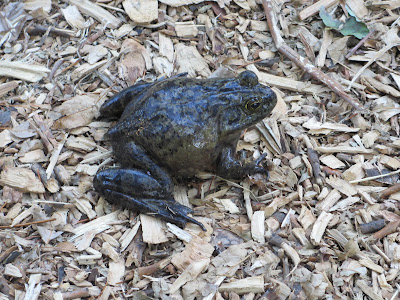Several days ago we had thundershowers during the evening and I went to the gym early the next morning when it was very warm and muggy. I got home about 7:00 a.m. and our cat was on our back patio staring down the largest frog I've ever seen.
I wouldn't have been more surprised to see an African lion. We don't have any natural ponds or streams near our home and I'm not aware of any artificial ponds either. It was just a few years ago that I became aware of small tree frogs in the vicinity as we've found two of them dead, and shriveled up, in our home. I have also heard the tree frogs croaking at night, but I've not seen a live one. Then this monstrous frog arrives almost literally on our doorstep and I am having to re-think everything I've thought about our local frog population.
I've never heard of a bullfrog locally and how could this gigantic frog be surviving so far from water? I decided to catch it and keep it in an aquarium for a few days. Then I found that it had giant hops, about a foot at a time, and it got pretty good air. But without water to escape into, it was an easy catch.
After several days and unsuccessfully trying to feed it two dozen large crickets, I decided I needed to let it go, but I was anxious about releasing it in our yard as I still can't believe it can survive there. Then I remembered that a friend of mine has a large artificial pond, several miles away, that he has introduced bullfrogs into from out of the area.
I called him and he let me release this frog into the pond.
While there, I saw several other resident bullfrogs.
It was quite a thrill seeing others of these monsters.
I also heard one of them croaking from a sanctuary of tall bullrushes and it was music to my ears. So deep, low, loud and powerful. Here is a link to some bullfrog calls.
The bullfrog is native to most of the east, south and midwest U.S. as far as about New Mexico and Colorado. Because their large, meaty legs, are good eating, frog farms all over the U.S. raised them and escapees soon found their ways into areas they were not native to. Now they are found in most of California except for the dry deserts and high elevations. They are generally not picky eaters and will eat other frogs, including bullfrogs, reptiles, fish, birds (I found a picture on the internet of one eating a small bird), mammals and invertebrates.









I have to admit, this was a pretty cool find. MUCH better than finding a rattlesnake curled up in the driving! He was fun to have around for a few days.
ReplyDelete